
As Pentagon releases further images, Hormuz attacks become clearer
Keen to build a stronger case against Iran, the United States military yesterday released more images of what it claims is the damage caused by Iranian limpet mines to the Japanese-controlled Kokuka Courageous product tanker. The ship was one of two to have come under attack last Thursday. Both the Kokuka Courageous and the Frontline-controlled Front Altair LR2 tanker are now in UAE waters, where investigations proceed.
The images made public by the Pentagon add to the grainy black and white footage earlier showing a team on a patrol boat removing something off the hull of the Kokuka Courageous. The new images clearly show a sizeable hole punctured on the side of the Japanese ship’s hull, which if proved correct, would dismiss earlier conjecture that the attacks involved torpedoes.
Limpet mines were also used against four tankers anchored off Fujairah last month.
“Iran is responsible for the attack based on video evidence and the resources and proficiency needed to quickly remove the unexploded limpet mine,” US Central Command said in a statement yesterday.
The narrative emerging from sources close to the Kokuka Courageous is that one mine went off while transiting the Strait of Hormuz and when crew were inspecting the side of the damaged ship soon after they spotted another limpet mine at which point the order was given to abandon ship.
Meanwhile, Splash understands the Front Altair, which suffered far more severe damage to its starboard hull, has been granted permission to proceed to an anchorage in the United Arab Emirates after surveyors had confirmed the ship’s safety. The crew is reboarding the ship with a view to carrying out a ship-to-ship transfer later this week. No pollution has been reported from the John Fredriksen-owned ship. Splash understands the attack damaged the Front Altair’s ballast tank and number three cargo tank.
Maritime security specialists Ambrey have issued a report in which they pinpoint exactly where they believe the attacks took place.
“It is likely the explosions were the result of limpet mines, placed while the vessels were underway,” Ambrey pointed out.
There are a limited number of occasions where the placement of limpet mines would have been likely. In the hours before the attack, both vessels had travelled similar routes, skirting the limit of Iran’s territorial waters on exit eastbound from the Strait of Hormuz. Prior to this, the Front Altair had loaded at Al Ruwais and the Kokuka Courageous at Al Jubail, the latter moving via a holding location in the Gulf. Ambrey stated that it is highly unlikely that the perpetrators of this attack would accept the degree of risk associated with placing explosive devices whilst the targets loaded at either location. It is more probable, Ambrey posited, the vessels were targeted as they slowed and their routes coincided, beginning in position 26 ̊11’N 54 ̊22’E – west of Sirri and Faror Islands.
“In the hours prior to the incident, and on the route taken by the target vessels, night fell from approximately 26 ̊19’17”N 55 ̊55’40”E to 25 ̊51’52”N 57 ̊00’26”E. This would have afforded the perpetrators about 84nm in which to deploy with minimal exposure, and thereafter detonate the devices 27nm SW of Bandar-e-Jask which, if it were the Iranians, afforded an opportunity to control the message,” Ambrey suggested.